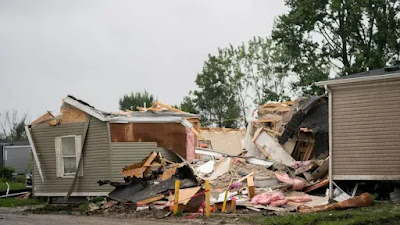In a heartbreaking turn of events, a series of fierce storms has wreaked havoc across the midwestern state of Michigan. These storms birthed at least six tornadoes that tore through the region, leading to loss of life, extensive property damage, and widespread power outages. The National Weather Service (NWS) confirmed the formation of several tornadoes, with one reaching an EF-1 strength on the Enhanced Fujita scale, boasting winds of up to 145 kilometers per hour (90 miles per hour). The destructive storms struck on a fateful Thursday night, leaving behind a trail of destruction and sorrow.
Tragically, the violent weather claimed five lives. In Kent County, a 21-year-old woman and two young girls tragically lost their lives in a collision between their car and an SUV. Lansing witnessed an 84-year-old woman meet her fate as a tree fell onto her home. The storms left many injured, prompting communities to reel while emergency responders tirelessly worked to evaluate and address the widespread damage.
The onslaught of storms wreaked havoc on power infrastructure, leading to extensive outages throughout the state. At the peak of this disaster, hundreds of thousands of residents found themselves without electricity, disrupting daily life and complicating recovery efforts. Wayne County bore the brunt of the impact, prompting County Executive Warren Evans to declare a state of emergency. This declaration has paved the way for resources to be funneled into tackling the array of challenges posed by power shortages, flooding, fallen trees, and storm debris.
The storms didn't just exact a human toll but also inflicted substantial damage on property and public spaces. Uprooted trees, downed power lines, and severely damaged buildings have left numerous communities grappling with the aftermath. Canton Township, home to around 100,000 people, experienced flooding that left local parks damaged and residents' basements inundated.
While establishing an immediate connection between specific weather events and climate change remains complex, scientists underscore the contribution of a changing climate to the escalation and frequency of extreme weather events. Severe storms, droughts, floods, and wildfires all fall under the spectrum of consequences attributed to climate change. While attributing these events to climate change with absolute certainty may not be possible, the shifting climate undoubtedly amplifies their occurrence and severity.
Acknowledging the gravity of the situation, Michigan Governor Gretchen Whitmer declared a state of emergency in Wayne and Monroe counties. This strategic move ensures that state resources are effectively directed towards facilitating response and recovery operations aimed at addressing the aftermath of the storms.
These recent storms underscore the significance of preparedness, seamless emergency response coordination, and community resilience in the face of increasingly erratic weather patterns. As scientists and policymakers grapple with the intricate relationship between weather events and climate change, a focused approach on mitigation and adaptation strategies becomes paramount. This approach is key to safeguarding lives and livelihoods from the mounting impact of severe weather events.



